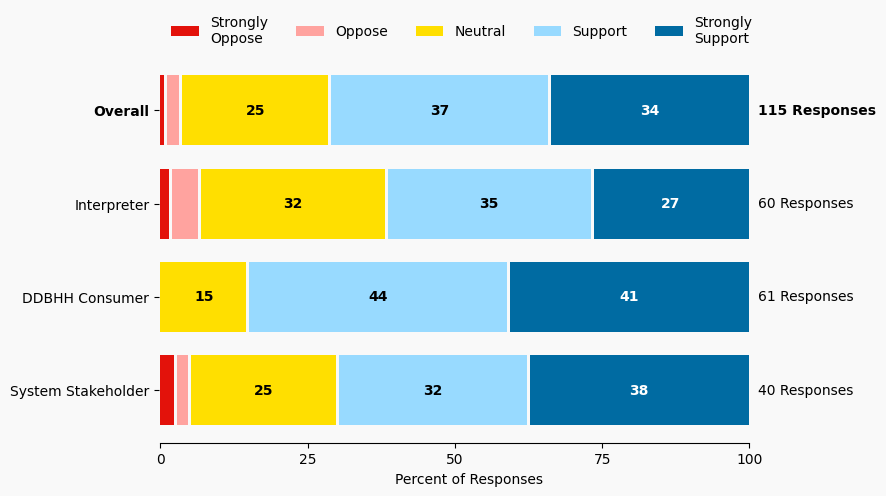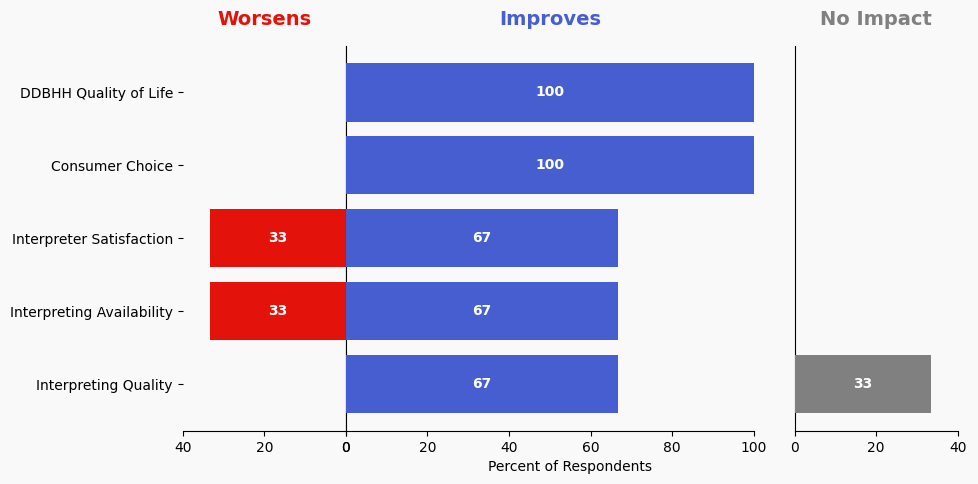81 Establish a Health Care Systems Advisory Board
Issue: Consumers and interpreters need a way to advise hospital systems on successful communication access.
Proposed Solution: A coalition, with the Minnesota Department of Health and the Minnesota Hospital consortium leading, develop community advisory boards for medical systems. Advisory Boards would consist predomitly of DDBHH constituents, one hearing interpreter, one Deaf interpreter, and DDBHH Community Health Workers. Advisory Boards would work with patient relations offices to provide feedback regarding services and identify areas for policy and systemic improvement.
Expected outcome: DDBHH people will have better health outcomes due to improved communication access.
Who is impacted: Consumers, interpreters, healthcare systems
Timeline: 6 months

Summary of Support Image Description
The stacked bar charts show how respondents rated their level of support and the total number of responses. The percentage for the five support levels is shown from left to right: Strongly Oppose (Dark Red), Oppose (Light Red), Neutral (Yellow), Support (Light Blue), and Strongly Support (Dark Blue).
Respondents may identify with multiple subgroups. The overall level of support is:
Overall
Strongly Oppose: 1%
Oppose: 3%
Neutral: 25%
Support: 37%
Strongly Support: 34%
Click to see the detailed image description for each subgroup.
Interpreter
Strongly Oppose: 2%
Oppose: 5%
Neutral: 32%
Support: 35%
Strongly Support: 27%
DDBHH Consumer
Strongly Oppose: 0%
Oppose: 0%
Neutral: 15%
Support: 44%
Strongly Support: 41%
System Stakeholder
Strongly Oppose: 2%
Oppose: 2%
Neutral: 25%
Support: 32%
Strongly Support: 38%
Overview of Respondents Opting for In-Depth Solution Analysis
After indicating their support level, 1% of the 115 respondents opted in to further assess whether the solution would worsen or improve on five metrics. Of the opt-in reviewers (2 respondents), 100% supported the solution, 0% were neutral on the solution, and 0% opposed the solution.
The remaining 113 respondents did not opt in to further assess the solution. Of these people, 70% support the solution, 25% were neutral on the solution, and 3% opposed the solution.
Reviewer Evaluation of Solution Effectiveness

Solution Effectiveness Image Description
The stacked bar charts show how respondents assessed the effectiveness of this solution based on five metrics. For each metric, the percentage of respondents is shown from left to right: Worsens (Red), Improves (Blue), No Impact (Gray).
DDBHH Quality of Life
Makes It Worse 0%
Makes It Better 100%
No Impact 0%
Interpreter Satisfaction
Makes It Worse 33%
Makes It Better 66%
No Impact 0%
Consumer Choice
Makes It Worse 0%
Makes It Better 100%
No Impact 0%
Interpreting Availability
Makes It Worse 33%
Makes It Better 66%
No Impact 0%
Interpreting Quality
Makes It Worse 0%
Makes It Better 66%
No Impact 33%
Reviewer Feedback and Insights
Interpreter
No comments were submitted.
Deaf, DeafBlind, Hard of Hearing
One comment from DDBHH Consumers suggests that the advisory board should include CHW, D/HH medical professionals, signing deaf professionals, and community members who regularly attend medical care, with representation from all types of healthcare systems. Another comment references Chicago’s health advisory group as an example.
System Stakeholder
No comments were submitted.
PREVIOUS SOLUTION
80 Pursue Legislation for Automated and Transparent Requests in Health Care Settings
Issue: DDBHH patients – who are the direct consumers of interpreting services – are disconnected from information regarding requests for interpreters for their appointments. This adds a layer of communication for all parties, and this causes greater stress to DDBHH patients.
NEXT SOLUTION
82 Promote Community Health Workers for Health Care Settings
Issue: DDBHH patients may struggle with full access and understanding to health care settings and providers. Interpreters are limited in their role for full support as needed. More Community Health Worker (CHW) services in ASL are needed.
Leave a Reply